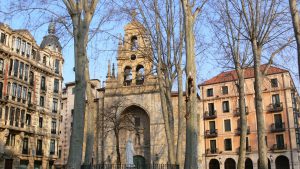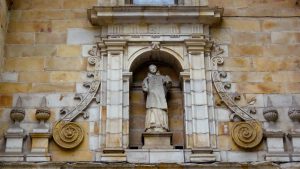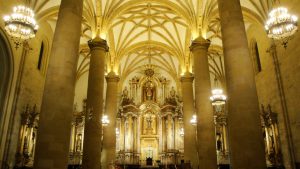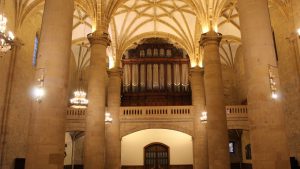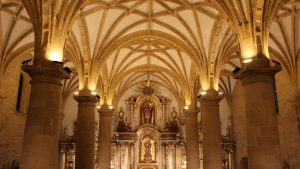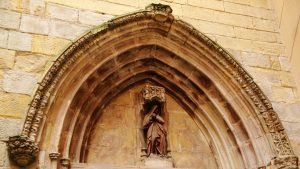OUR CHURCH
You are at the entrance gate to the temple of Saint Vincent Martyr of Abando. Before entering, we tell you a little story. It would appear that at some point the mediaeval church serving the wealthy parish of Abando was eventually swamped by the tombs of its parishioners, and the decision was taken to construct the present building, on which work began around the mid-16th century.
This is a real gem of Renaissance religious architecture. The temple of Saint Vincent Martyr of Abando is one of the very finest examples of its kind in the Basque Country. Constructed basically of ashlar and rubblework, the church stands on the finest site in the old parish and originally presided over a tree-lined area that is recalled today by the Albia gardens. This is a green space that the parish demanded that retained after Abando was absorpted by Bilbao in 1890.
Now, you can enter from the left. You will see that there is a triptych of Baptism of Jesus painted by Iñaki García-Ergüin. Formerly in this place was the baptismal font. So we also remember the small stained glass window overlooking the main facadeNow, you can enter from the left. You will see that there is a triptych of Baptism of Jesus painted by Iñaki García-Ergüin. Formerly in this place was the baptismal font. So we also remember the small stained glass window overlooking the main facade.
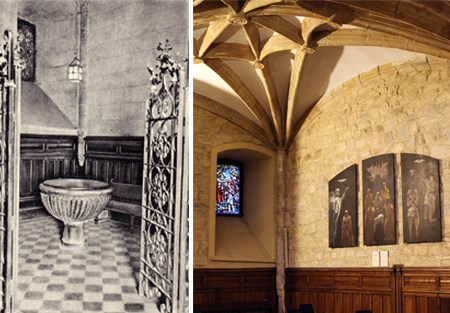
If you go a little, you’ll see the building structure. It is a dignified and large floor, composed by a central nave flanked by two aisles in five sections, all the same height, defined by tall columns with classical Doric capitals from which spring the uniformly Gothic arches and ribbing of the vaulting, each with four points with ribs around the pole and nine keystones in all.
With its spacious vaulting all at the same height and resting on classical columns, Saint Vincent is one of the purest examples of this kind of column-based church, as not even the high chapel has an autonomous area to distinguish it. Natural light is insufficient due to the small size of the windows opened in pairs in the area of the head.
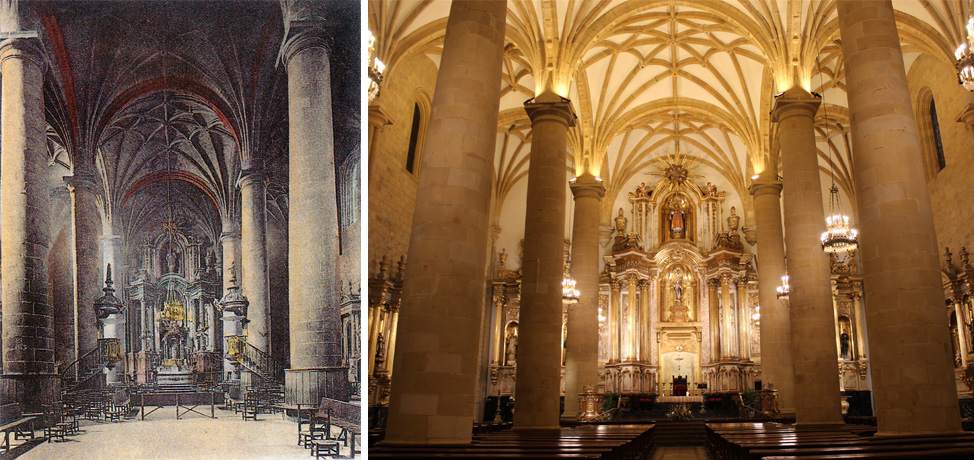
Go ahead to the first chapel, where you can see the baptismal font accompanied by a bronze relief of Ricardo Iñurria. Over it, a large painting, also painted by Iñaki García-Ergüin, shows the Last Supper of Jesus and presides with great solemnity the «monument» every Holy Thursday.
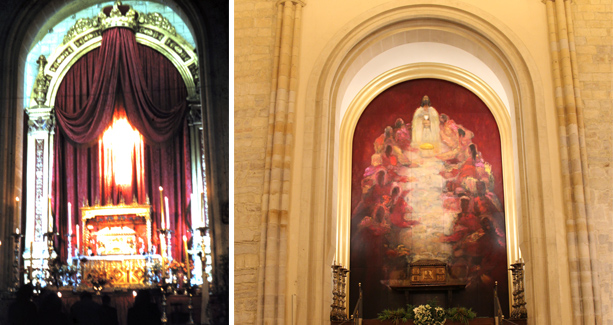
Go ahead and find the altarpiece of the Milagrosa Virgin flanked by carvings of Saint Ignacio and Saint Francisco Javier and besides, the Carmen or Villarias Chapel, with square floor and edge vault. Inside, it must be emphasized the altar dedicated to Our Lady of Carmen and carvings of Father Jesus of Passion and Our Lady of Branches and Rosary, both of sculptor Luis Álvarez Duarte, who go outside carried by brothers of the Brotherhood of the Passion, which is based in the same parish, in the Holy Week of Bilbao.
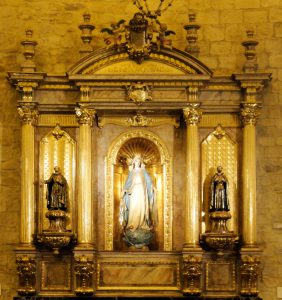
In the most advanced section you can see three altarpieces of gilded wood. The main altarpiece, was designed by architect Juan Blas de Hormaeche in 1860, is neo-Elizabethan style and it is composed by a Baroque statue of the Immaculate Conception and the holder of the parish, Saint Vincent Martyr, coeval to the structure and large correction in the way, wearing chasuble of deacon and carrying palm symbolizing his status as martyr. On the left, on the Gospel side, you can see the altarpiece presided by the Sacred Heart, Saint Anthony, Saint Ramon Nonato and Saint Expedito in height. In the same way, on your right, on the side of the Epistle, there are sculptures of great quality as Saint Alphonsus Liguori and Saint Gerardo, work of Higinio Basterra, or Saint Joseph disposed in the head, with a relief of the Blessed Trinity in its highest part. The altarpieces, that accompany main altarpiece on the left and on the right, were designed by Ricardo Bastida.
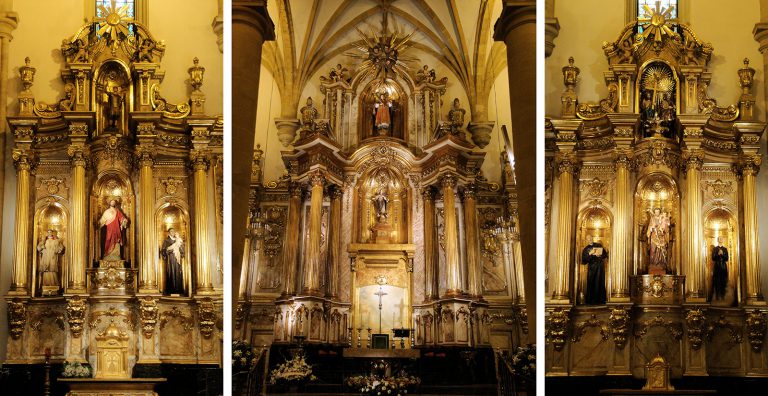
Arriving at the head of the temple, visit the great sacristy. Enter through the side small door that is on the right of the main altarpiece. It has two Baroque paintings around 1780, an interesting Crucifix, an ancient carving of Saint Vincent and artistic furniture for practical use, such as chests of drawers, a washstand or laver of Eucharistic equipment, dated 1914, and an original frame of hours and services, without use, for the various priests who had the church.
Leaving the sacristy, you’ll find another chapel, the Chapel of Good Success or Zumelzu. With square floor and topped by a recessed dome. Inside, it can be seen an image of Our Lady of Sorrows, dress carving, and recumbent Christ in the urn, works of sculptor Quintín de Torre. In addition, the work of the sculptor Jesús Cepeda, Holy Christ of Health, stands out, owned by the Brotherhood of the Passion.
When you leave the chapel, you can contemplate the altarpiece of Our Lady of Perpetual Help in beautiful Icon. Next to the Icon, there is an image of Saint Roque with his whippet and pumpkin, star of epidemics and plagues, reminiscent of what happened in the past in Bilbao, and Saint Isidro farmer, whose brotherhood grouped together many farmers who were in this porch in the past.
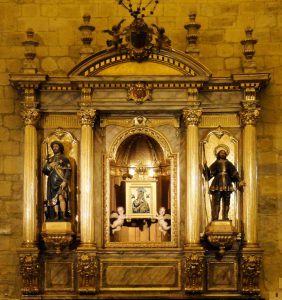
Continuing along the right side to exit, you’ll find one of the two entrances to the temple. It is the older-looking. It is typical late Gothic, with molded and pointed jambs and archivolts. Oriented to the noon, it gives onto a walkway respected by the parish buildings that otherwise lay siege to the church. This arcade is crowned in its tympanum by a small wooden polychrome virgin.
When you go out the other door to which you entered, it highlights an excellent Christ which was sculpted by Julio Beobide. The small stained glass window represents the Cleansing of the Temple by Jesus. Next to it, the remains of the famous writer Antonio de Trueba repose under the relief of a swan, star of one of his poems.
Leave the temple to watch the main access which is at the foot of the church and forms part of the main façade oriented to the sunset, made from 1556. A giant niche, set between two piers which provide a base for the modern tower-steeple, houses a simple entrance way under a basket-handle arch decorated by a few fantastic figures. Above the access is a small niche for a stone figure of Saint Vincent Martyr with a straight window above. The tower-steeple dates from 1894 and was designed by José María Basterra. It was built by the Council of Bilbao, after the transfer of some lands and was made with stone from the old Town Hall.
Finally and before finishing the visit of the temple, we invite you to sit quietly on a bench to pray for a few minutes with the following prayer.
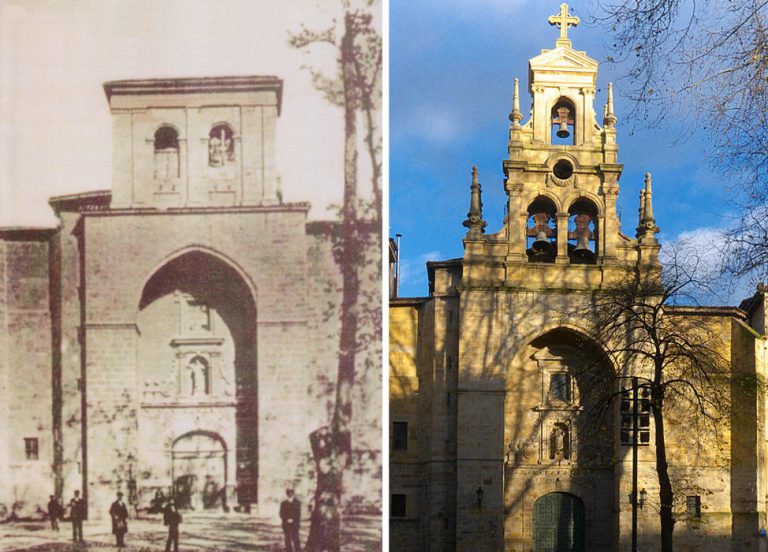
PRAYER OF SAINT VINCENT MARTYR
Everlasting God, to whom all hidden things are revealed, who sent into the world Your Only Begotten Son, our Lord Jesus Christ, conceived through the Holy Spirit, born of the Virgin Mary, that He might take on Himself the punishment of our sins and by His resurrection, snatch us from the gates of hell, grant to our hearts such steadfastness of faith that confessing Christ, Your Son, we may not perish but may be joined to Him in the confession of Your Holy Name.
Amen.
THE GOOD SHEPHERD (Psalm 23)
You, Lord, are my shepherd. I will never be in need. You let me rest in fields of green grass. You lead me to streams of peaceful water, and you refresh my life.
You are true to your name, and you lead me along the right paths. I may walk through valleys as dark as death, but I won’t be afraid. You are with me, and your shepherd’s rod makes me feel safe.
You treat me to a feast, while my enemies watch. You honor me as your guest, and you fill my cup until it overflows. Your kindness and love will always be with me each day of my life, and I will live forever in your house, Lord.

